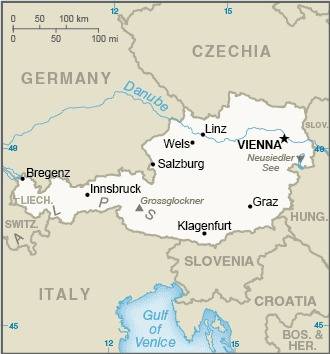
The Republic of Austria is situated in Central Europe. It shares borders with:
| • | Switzerland and Liechtenstein in the west, |
| • | Germany, Czech Republic and Slovakia in the north, |
| • | Hungary in the east, and |
| • | Slovenia and Italy in the south. |
The population of Austria on January 1, 2025 was 9,198,214, according to Statistik Austria. From 2015 to 2025, Austria’s population increased by 6.6%. Vienna, the capital, had a population of 2.03 million in 2025.
Austria has an area of 32,383 square miles. The western and southern regions of Austria, containing the Austrian Alps, are mountainous and heavily forested. There are fertile plains in the eastern parts of the country and in the valley of the Danube River, which flows through Austria for a distance of 217 miles.
The present Austrian frontiers were determined by the Treaty of St. Germain in 1919. The occupation of Austria following World War II was ended by the State Treaty for the Re-establishment of an Independent and Democratic Austria in 1955. The treaty limits the manufacture and possession by Austria of certain types of military weapons, including atomic weapons.
Under the Austrian Federal Constitution Act of 1920, as amended in 1929 (the “Constitution”), Austria is a democratic and federal republic, with legislative and executive powers divided between the federal government and the nine constituent provinces.
The legislative power of the federal government is vested in a bi-cameral legislature consisting of the Nationalrat and the Bundesrat. The members of the Nationalrat are elected for a period of five years by direct, secret, popular suffrage under a system of proportional representation. The Nationalrat may be dissolved before the termination of the term of five years for which it is elected, by its own action or, in certain circumstances, by the Federal President. The present Nationalrat was elected on September 29, 2024. The members of the Bundesrat are elected periodically by the legislatures of the provinces in proportion to the populations of the nine provinces.
The executive powers of the federal government are vested in the Federal President, the Chancellor and the Cabinet. The Federal President is elected by direct, secret, popular suffrage for a term of six years. Dr. Alexander Van der Bellen was re-elected Federal President on October 9, 2022. The chief constitutional powers of the Federal President are the appointment of the Chancellor and his Cabinet and the dissolution of the Nationalrat. The present administration was formed on March 3, 2025 by a coalition of the Austrian People’s Party, the Social Democratic Party of Austria, and The New Austria and Liberal Forum and is led by Christian Stocker of the Austrian People’s Party as Chancellor and Andreas Babler of the Social Democratic Party of Austria as Vice-Chancellor.
The judicial power is exercised by the federal courts. Courts of last resort are provided for questions of civil and criminal law and for questions of administrative law. A separate constitutional court has primary competence to determine the constitutionality of all legislative and administrative acts of the federal government and the provinces.
132